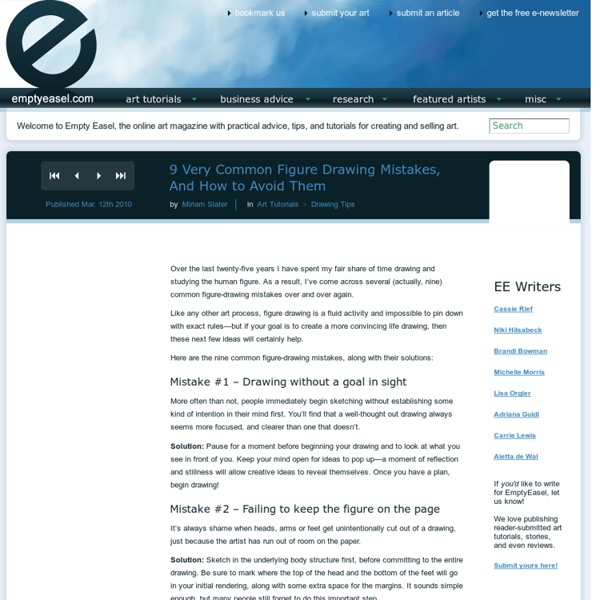9 Very Common Figure Drawing Mistakes, And How to Avoid Them

Art Anatomy
by Franklin Einspruch Copyright Franklin Einspruch. Please see License for permitted usage. Please note that the view below is in a provisional state. Dedication To my parents and grandparents I must study politics and war, that my sons may have liberty to study mathematics, philosophy, and commerce, so that their children, in turn, may have the right and privilege to study painting, poetry, and music. - John Adams Acknowledgements The creation of this manuscript was made possible by a generous grant from a foundation whose name, by request, has been withheld. The University of Miami School of Architecture kindly administered the grant and appointed me as a Research Associate for its duration. The idea in the Epilogue of the communion between eye, hand, and mind must be credited to a dear colleague at the SOA, David Fix. I would like to thank my mother for reviewing the manuscript. Foreword This book is especially intended as a primer on artistic anatomy. Part 1: Beginning How to Use This Book
How I See Color - A Tutorial by *purplekecleon on deviantART
Stan Prokopenko's Blog : How to Draw the Head From Any Angle
The Basic Forms To draw the head from any angle you must first understand its basic structure. Look past all the distracting details and visualize the underlying forms. The head deconstructed into its basic forms, is a sphere as the cranium and a block as the jaw and cheek bones. A Sphere as the Cranium The sides of the head are flat, so we can slice off a piece from both sides of the ball. A Block as the Jaw and Cheek Bones Attach the shape of the jaw. Constructing From Any Angle Step 1 – Determine the angle of the ball The angle of the head is established at the very beginning of the drawing with the ball. X Axis - The up and down tilt is established by the angles of the horizontal and vertical lines in the oval. Y Axis - The direction the head is turning (left or right) is established by the width of the oval. Z Axis - The twist is established by the angle of the center line, the angle of the oval and the placement of the oval on the ball. Step 2 – Find the thirds Step 3 – Add the jaw
How to Draw Ears
For a video version of this tutorial visit www.proko.com/how-to-draw-ears-anatomy-and-structure In this tutorial I will go over the parts of the ear and suggest an easy way to remember all these complex shapes. At the end, I will show a step by step of an ear drawing. Basic Forms The simplified volume of the ear is very much like a megaphone. Just Remember “why?” At first glance the shapes in the ear seem random and confusing. Placement of the Ears The ears lie in the middle third of the face. In Perspective During an up-tilt or down-tilt the placement of the ears is very important since doing it incorrectly can break the illusion of a tilt. Anatomical Information Shading the Complex Forms of the Ear Concha The concha is the bowl-shaped part that attaches the back of the ear to the head. Helix The Helix is a semi-cylindrical form and should be shaded as such. Antihelix The antihelix is the Y shape inside the ear. Tragus and Antitragus Lobule Drawing the Ear 5. Made a video version of this tutorial.
Patricia Schu Art Blog
Library reference-Humans by #ArtistsHospital
How to Draw a Portrait of the Head
The most important part of a drawing is the start, not the finish. This tutorial will focus on how to start a portrait drawing, using basic blocking-in techniques. When drawing a portrait from life, you don’t want to just jump-in and draw. In addition, whenever I do a head study, or a portrait, I don’t start out by trying to capture a “likeness.” Here is my process for drawing portraits: 1. Mark the top of skull, not the hair, then locate the line of the chin, mark the back of the skull and two lines for the angles of the front of the skull. Look for the bone structure of the skull not the features of the face—that will come later. 2. Divide the head into thirds: one third is from the top of the head to the top of the eye socket; the second is from the top of the eye socket to the base of the nose; and the third is from the base of the nose to the bottom of the chin. Next, locate the position of the eyes and the middle of the ears. 3. 4. 5. For more drawings and tips from H.
Icon Archive - 29,900 free icons
Figure Drawing Ebooks - How to Draw People
Related:
Related:



